 Politics
Politics  Politics
Politics  Weird Stuff
Weird Stuff Ten Bizarre Facts About The Doge Meme
 Our World
Our World 10 Ways Your Christmas Tree Is More Lit Than You Think
 Movies and TV
Movies and TV The 10 Coolest Stars to Set Sail on The Love Boat
 History
History 10 Things You Didn’t Know About the American National Anthem
 Technology
Technology Top 10 Everyday Tech Buzzwords That Hide a Darker Past
 Humans
Humans 10 Everyday Human Behaviors That Are Actually Survival Instincts
 Animals
Animals 10 Animals That Humiliated and Harmed Historical Leaders
 History
History 10 Most Influential Protests in Modern History
 Creepy
Creepy 10 More Representations of Death from Myth, Legend, and Folktale
 Politics
Politics 10 Political Scandals That Sent Crowds Into the Streets
 Weird Stuff
Weird Stuff Ten Bizarre Facts About The Doge Meme
 Our World
Our World 10 Ways Your Christmas Tree Is More Lit Than You Think
Who's Behind Listverse?

Jamie Frater
Head Editor
Jamie founded Listverse due to an insatiable desire to share fascinating, obscure, and bizarre facts. He has been a guest speaker on numerous national radio and television stations and is a five time published author.
More About Us Movies and TV
Movies and TV The 10 Coolest Stars to Set Sail on The Love Boat
 History
History 10 Things You Didn’t Know About the American National Anthem
 Technology
Technology Top 10 Everyday Tech Buzzwords That Hide a Darker Past
 Humans
Humans 10 Everyday Human Behaviors That Are Actually Survival Instincts
 Animals
Animals 10 Animals That Humiliated and Harmed Historical Leaders
 History
History 10 Most Influential Protests in Modern History
 Creepy
Creepy 10 More Representations of Death from Myth, Legend, and Folktale
10 Dramatic Events From Europe’s Longest War
Europe has weathered many wars and catastrophes, but few have been as devastating as the Thirty Years’ War. Between 1618 and 1648, Europe’s great powers engaged in a vicious, unending conflict that killed millions of people. Germany lost 20 percent of its total population and some regions saw 75 percent of their inhabitants disappear from the face of the Earth. Filled with massacres, assassinations, epic battles, secret alliances and betrayals, the Thirty Years’ War reads like a Game Of Thrones best-of reel.
The war was unmatched in its duration and intensity—conflicts like the Hundred Years War actually contained long periods of peace, but the Thirty Years’ War saw fighting continue for three straight decades, making it Europe’s longest continuous conflict. Many dramatic incidents unfolded over the course of those fateful decades, but these 10 tower above the rest.
10The Defenestration Of Prague
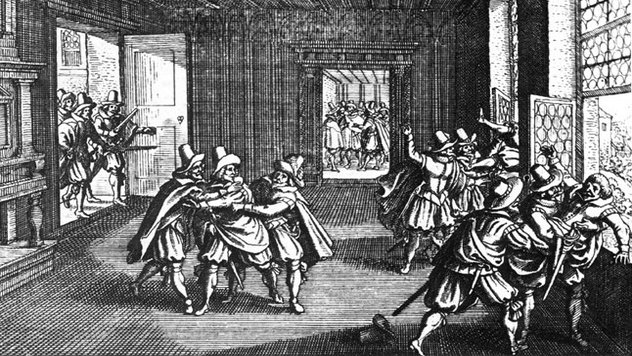
In 1517, a disgruntled priest named Martin Luther nailed a list of complaints to his local cathedral and unleashed a religious revolution. The Protestant movement triggered decades of religious warfare, but peace was largely restored to central Europe by 1555. Yet the underlying problems hadn’t been resolved and continued to bubble under the surface.
In 1617, Ferdinand II of Austria was crowned King of Bohemia. Shortly afterward, he also became Holy Roman Emperor, theoretically the overlord of most of Germany. Ferdinand was a devout Catholic from the powerful Hapsburg family, which controlled much of Europe. As such, he was widely distrusted and disliked by the Protestant Bohemians. Shortly after his coronation, Ferdinand prevented Protestant chapels from being built in two Bohemian towns. This was seen as a violation of the religious freedom the Hapsburgs had promised to Bohemia.
In response, a number of Protestant nobles seized Ferdinand’s regents in Prague and threw them out a window in Prague Castle. Miraculously, the emperor’s lackeys survived the drop. How? The Catholics claimed that guardian angels swooped in to carry them safely down to earth. Protestant sources say they landed in a huge pile of manure that was under the window. Either way, Ferdinand II regarded the incident as a declaration of war. The consequences would be apocalyptic.
9The Empire Strikes Back
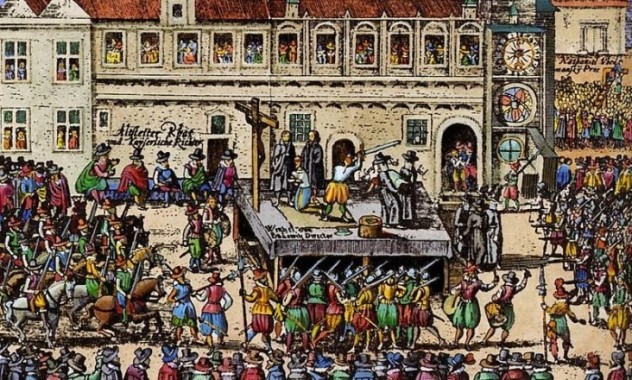
Determined to make an example of the rebellious Bohemians, Emperor Ferdinand summoned the aid of the Catholic League, an alliance of German Catholics formed a few years earlier by Maximilian I of Bavaria. To counteract this, the Bohemians tried to enlist the rival Protestant Union by electing Frederick V of the Palatinate as their king. However, the other leaders of the Protestant Union were reluctant to get involved and told Frederick they would only help defend his German lands, not the Czechs of Bohemia. The only real help came from the ferocious Protestant ruler of Transylvania, Gabor Bethlen, who took advantage of Ferdinand’s focus on Bohemia to invade Hungary.
By 1620, the Catholic League’s army, led by the formidable Marshal Tilly, had burned its way through western Bohemia and was closing in on the rebel capital of Prague. On November 8, the Catholics cornered the Bohemians on the White Mountain. The Catholics outnumbered the rebels and boasted powerful cavalry, artillery, and the best commanders in all of Europe. Unsurprisingly, the rebels quickly crumbled and were overwhelmed by Tilly’s experienced troops. The battle was over in under an hour. Frederick fled and was soon dubbed “the Winter King” because his reign failed to reach the new year.
Emperor Ferdinand kept his promise to punish the Bohemians and executed the leading rebels in Prague’s Old Town Square, a deed which was soon made infamous by woodcuts like the one above. The Protestant Bohemian nobility saw much of their wealth confiscated. Plans were put in place to forcibly convert the Bohemians to Catholicism, and Protestantism was officially banned in 1627. The violence would continue against the Bohemians for the course of the entire war. By the time peace finally came in 1648, Bohemia’s population had decreased from 3 million to just 800,000.
8Summer Of The Winter King
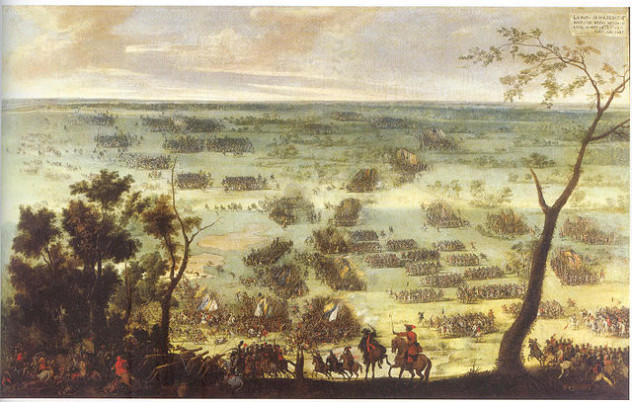
Over the next few years, the Winter King fled through the Empire, pursued by Tilly and the Catholic League. His general Mansfeld had managed to bring an army intact out of Bohemia, though it was seriously outclassed by the Catholic forces. After being forced out of the Palatinate, Mansfeld occupied Alsace during the winter of 1621. Through brutal recruiting, he managed to bring his forces up to 22,000 by the spring of 1622.
Meanwhile, the Protestant Union remained too frightened of the emperor to enter the war and disbanded in 1621. However, the Margrave of Baden-Durlach raised an army of 11,000 in support of the Winter King. And the fanatical Christian of Brunswick built an army of 10,000 men virtually from scratch in Saxony, ruthlessly extorting supplies and money from the locals.
But the Catholics rose to the challenge and the year 1622 was a disaster for the Protestants. In May, Tilly annihilated the Margrave of Baden-Durlach’s army at Wimpfen. In June, he savaged Christian of Brunswick at Hochst. Demoralized, Mansfeld and Christian broke through the Catholic lines and marched their remaining troops to safety in the Netherlands. They returned in 1623, planning a combined attack with the Transylvanian Gabor Bethlen. It didn’t go very well—the unstoppable Tilly slaughtered Christian’s forces and Bethlen quickly made peace with the emperor. The Protestants were in disarray and the Winter King ceased to be a significant force in the war.
7The Dessau Bridge
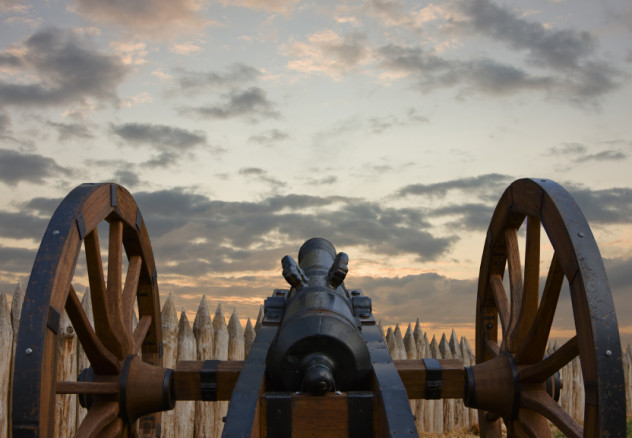
Triumphant, the emperor’s forces marched north through Germany, burning Protestant towns and seizing castles. Ironically, this near-complete victory by the Catholic League was intolerable to the Catholic French, who began to fear that the Hapsburgs would soon dominate all of Europe. As a result, King Louis XIII and his adviser Cardinal Richelieu cast aside religious bonds and decided to oppose Ferdinand. In what came to be known as the Danish Phase of the war, the French and English agreed to send huge sums of money to King Christian IV of Denmark, who became the new Protestant champion.
The Danes’ first move was to get the old band back together—Mansfeld stormed into northern Germany with 12,000 mercenaries, Gabor Bethlen invaded Moravia, and Christian of Brunswick’s peasant forces ravaged everything in their path. Meanwhile, Christian IV advanced down the Weser to face Tilly and the Catholic League.
But things went wrong when Mansfeld thought he saw an opportunity to defeat Count Albrecht von Wallenstein, who headed the Imperial forces in Dessau. The cunning Wallenstein had actually lured Mansfeld into a devious trap, disguising his true strength to fool his opponent into trying to storm the Dessau Bridge. As Mansfeld’s forces tried to cross, Wallenstein opened up with hidden artillery, creating a grisly corridor of death.
The Protestant army disintegrated and Mansfeld himself died shortly afterward. As a result, Wallenstein was able to dispatch 8,000 crack reinforcements to Tilly. Realizing the tide had turned, Christian IV tried to retreat, but Tilly chased him down and broke the Danes at Lutter am Berenberge. The Danish Phase was effectively over.
6The Massacre Of Magdeburg
Thousands of cities, castles, and hamlets were wiped from the map completely during the Thirty Years’ War. One of the most tragic massacres occurred at Magdeburg, a Lutheran stronghold in Northern Germany.
After the Danes had been thoroughly defeated, Cardinal Richelieu switched his financial support to King Gustavus Adolphus of Sweden. A gifted military leader, Gustavus Adolphus had expanded Swedish power in the Baltic through a series of wars and seemed the perfect choice to become the new standard-bearer for the Protestant cause. However, the Protestant princes had mixed feelings about his arrival in Germany. For one thing, he forced many cities that had tried to remain neutral to officially declare war against the emperor. He also demanded huge financial levies to supply his army.
The Swedes proceeded to enact a scorched-earth policy, burning and raiding Catholic territories to deprive the larger Imperial forces of the resources they needed to continue the war. In May 1631, a beleaguered Catholic army led by Tilly laid siege to Magdeburg while the Swedes were elsewhere. After holding out valiantly for a month, the city’s defenses were breached at two locations. Starved, frenzied, and frustrated, the Imperial troops stormed into the city and unleashed an orgy of violence.
The killings lasted for days. Tilly retained control of just enough troops to guard the cathedral, where about 1,000 citizens took refuge, but elsewhere the slaughter was absolute. Even the children were killed. The Swedish army, marching in vain to relieve the city, could smell the burning bodies for miles off. Over 20,000 residents of Magdeburg were murdered during the sack. A year later, just 425 people lived in the ruins of the once-great city.
5Sweden Turns The Tide
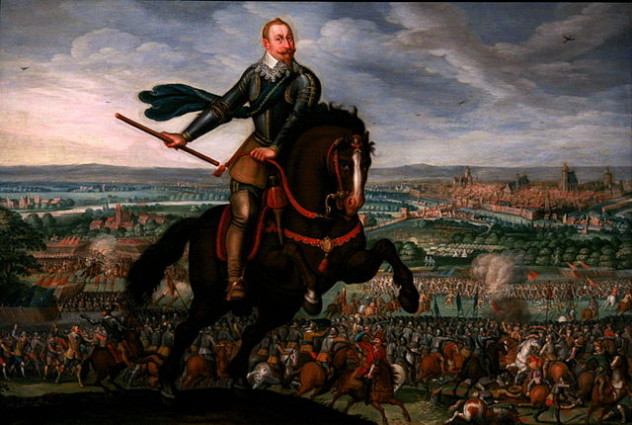
Gustavus Adolphus used the horror of Magdeburg to rally the German Protestants to his side. Fearing that they would be the next Magdeburg, many previously reluctant German states rushed to side with the Swedes. On September 17, 1631, they got their chance for vengeance.
At Breitenfeld in Saxony, Gustavus Adolphus led over 40,000 Swedish and Saxon soldiers against Tilly’s Imperial army. Although Tilly commanded around 37,000 soldiers, the Swedes had the definite advantage going into the battle. That’s because Gustavus Adolphus was a visionary general whose innovations changed the way Europeans fought wars. The Imperial forces would prove no match for his crack Swedish troops.
Once the battle was joined, Tilly’s veterans broke the Saxons, who largely fled the field. But this drew the Catholics out of position and the Swedes countered with volleys of well-drilled musketry. The battle lasted nearly six hours before Gustavus’s counterattack broke the Catholic line. The Swedes swept in, sending the Imperials into complete disarray.
Tilly’s army virtually vanished, although the old warhorse managed to rally a few survivors at Halberstadt. The Swedes lost only a few thousand men. It was the first major Protestant victory of the war and finally threw the Catholic League onto the defensive.
4The Lion Of The North Falls
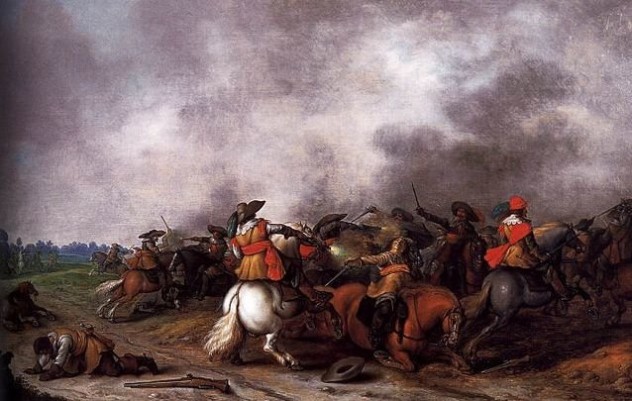
At the start of 1632, Gustavus Adolphus appeared unstoppable. He had won every major engagement he had fought in, including the decisive Battle of Breitenfeld. Wurzburg, Mainz, the Lower Palatinate, and other key Catholic states fell to the Swedish onslaught. Tilly’s decimated forces were unable to mount any resistance and scrambled back to their base in Austria. Tilly himself was killed early in the year.
Reluctantly, Emperor Ferdinand reinstated the treacherous Wallenstein as a general to try and stop the Swedish advance. On November 16, 1632, Wallenstein, together with his trusted ally Pappenheim, engaged the Swedish king outside the town of Lutzen, which Wallenstein’s men set on fire at the start of the battle. The Swedes saw early success—Pappenheim was killed by a cannonball and his forces collapsed, leaving Wallenstein to fight the Swedes by himself.
Thick plumes of smoke from the burning city obscured the battlefield and any sort of order or strategy disappeared in the grey haze. Adolphus led a daring cavalry charge through the charred battlefield but was shot in the arm and became separated from most of his men. Disoriented, he tried to return to his lines but rode the wrong way and encountered a group of enemy horsemen, who chased his small group down, stabbed him, and pulled him off his horse. In one account, the horsemen asked who he was and Gustavus replied, “I was the king of Sweden.”
With Swedish cavalry audibly approaching through the smoke, one of the Imperial horsemen was seen firing his pistol into the king’s head. The blast was heard around Europe. The Battle of Lutzen was a victory for the Swedes, who rallied to overwhelm the men who had killed their king, but no victory could replace Gustavus Adolphus. The war would continue.
3Wallenstein’s Betrayal And Murder
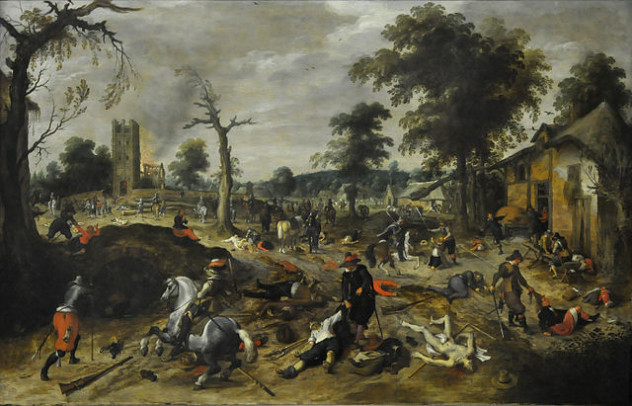
Albrecht von Wallenstein was a megalomaniac, a psychopathic warlord, an astrology freak, and one of the richest men in Europe. He wasn’t born into the nobility, but the chaos of war allowed him to embark on an unprecedented rise. Loyal to no one, he was an island in the middle of a sea of conflict. A Bohemian Protestant, Wallenstein converted to Catholicism in 1606, probably to get in with the Jesuits, who arranged for his marriage to a rich widow. When the emperor invaded Bohemia at the start of the war, Wallenstein personally equipped a cavalry regiment to support the invasion.
Impressed by this show of loyalty, Ferdinand appointed Wallenstein governor of Bohemia after the rebels were crushed at White Mountain. Wallenstein ruthlessly used the position to line his own pockets, selling himself confiscated estates at half-price and then paying with debased coinage. As a result, he gained one of the largest fortunes in all of Europe. But he wanted more.
Early in the war, the humiliated emperor had been forced to rely on the army of the Catholic League, commanded by Tilly and overseen by his rival, Maximilian of Bavaria. But when the Danes invaded, Wallenstein approached Ferdinand and offered to equip a huge mercenary army from his own funds. In repayment, he would be allowed to keep all the loot he could extract from occupied areas. The emperor agreed, and Wallenstein began a relentless campaign of plunder and theft. Before long, his personal army of 100,000 “overspread the Empire like locusts, battening on the lands of friend and foe alike.”
The Catholic League was deeply alarmed by this development and forced Ferdinand to dismiss Wallenstein and his army in 1630. The move was premature; Gustavus Adolphus landed in Germany the following year. To make matters worse, Ferdinand’s spies intercepted letters indicating that Wallenstein was considering joining the Swedes. Backed into a corner, Ferdinand swallowed his pride and rehired Wallenstein, who was granted complete power over the army. But Ferdinand knew the warlord was vindictive and likely to turn against him.
After Wallenstein killed Gustavus Adolphus at Lutzen, Ferdinand decided to dispatch his renegade general once and for all. Paranoid and sick from gout, Wallenstein purged his army of suspected mutineers in 1633 and locked himself up in his fortress outside Prague. Correctly suspecting Ferdinand was trying to get rid of him, Wallenstein began openly plotting to make himself king of Bohemia. This alarmed his generals, who believed he had lost his mind, and they accepted an order from Ferdinand to remove their leader. As Wallenstein’s loyalists attended a dinner at Cheb Castle, a group of Irish and English mercenaries entered and slaughtered their way through to the general’s chambers. Wallenstein was stabbed to death by his own officers in his room.
2The Spanish Collapse
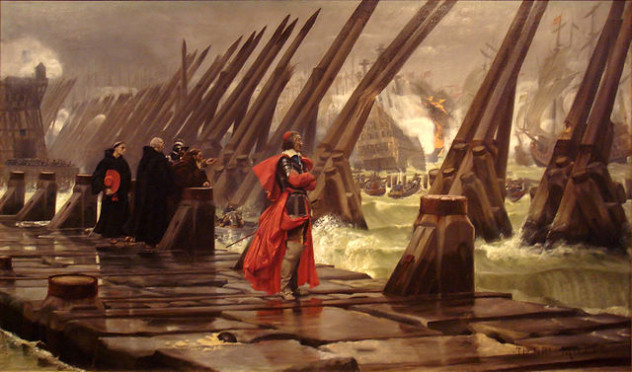
Without Gustavus Adolphus, the Swedes were less effective. In 1634, they suffered a crushing defeat at Nordlingen. They might have won if they had attacked at once before the Imperials could be reinforced, as their more aggressive generals wanted. And they might have won if they had waited for their own reinforcements, as their more cautious generals wanted. But they were divided and attacked at the worst possible time instead.
Having finally run out of proxies, Cardinal Richelieu (depicted above at the siege of La Rochelle) decided it was time for French troops to enter the fray. The war settled into a bloody but inconclusive period: the Swedes repeatedly surged south and were forced back to the Baltic, an invasion of France melted away, and French campaigns in Germany came to little. Emperor Ferdinand II died in 1637, having spent his entire reign at war. Before his death, he agreed to scale back his anti-Catholic policies, allowing many German Protestants to reconcile themselves to the Empire and isolating the French and Swedes.
But the Imperials were also growing weary of war. As well as Austria and the Holy Roman Empire, the Hapsburg family controlled the powerful Spanish Empire, which spanned the entire globe. During the Thirty Years’ War, the Spanish Hapsburgs funneled gold from their American mines into the war effort in central Europe. Spain also fought Protestant rebels in the Netherlands, which it controlled with violence and terror for over a century.
But the brutal fighting in the Low Countries and constant stipends to the Imperial armies eventually drained Spain’s formidable resources. Furthermore, the Spanish king tinkered with his financial policy and ended up causing inflation to skyrocket to the point that Spanish goods were virtually worthless. The Spanish people had enough and open rebellions engulfed Catalonia and Portugal. The Spanish army in the Netherlands withered away to nothing. These events rendered the Spanish helpless to assist their Hapsburg cousins in Germany. The war was coming to an end.
1The Treaty Of Westphalia
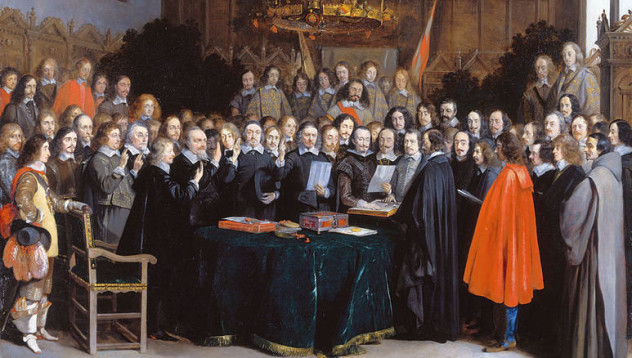
By 1640, the Hapsburgs were seeking to end the war. Spain had collapsed and rampaging armies were sucking the Holy Roman Empire dry. Much of Central Europe had descended into complete anarchy without any political leadership whatsoever.
Most factions in Europe were ready for peace, but the tangles of war were difficult to untie. Swedes, Danes, Bavarians, French, Austrians, and a thousand little princelings all found reasons to renew the war and wanted old feuds settled before they went to the peace table. Cardinal Richelieu died in 1642 and the French suffered a bad defeat at Tuttlingen the next year. The Swedish army force-marched the length of Germany to preemptively attack the Danes, who were planning to join the emperor. As the Catholic French fought the Catholic Hapsburgs and Protestant Danes fought Protestant Swedes, all pretense of a religious war had been abandoned.
The warring parties eventually met in Westphalia in 1644. The talks would drag on for the next four years. As the negotiations went on, so did the violence in the countryside. Finally, with the Empire in tatters, Emperor Ferdinand III capitulated to a number of demands and signed the Treaty of Westphalia. Protestantism was to stay in Europe and the French were to play a larger role than ever before in the fate of the continent. In 1648, the war was finally over.
+The Devastation
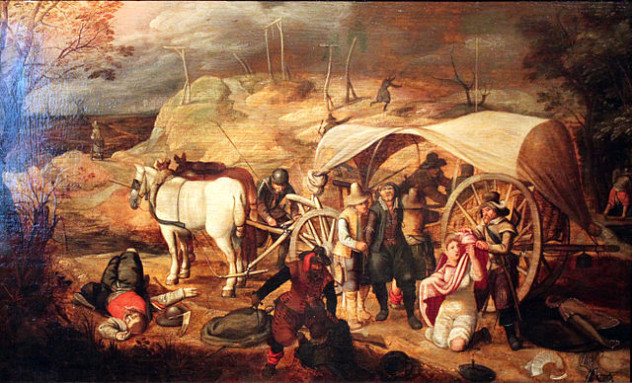
The rulers of the time were incapable of paying or supplying large standing armies. Instead, they adopted the “wolf-strategy” in which armies were expected to live off the land, looting food and funds from the helpless civilians in their path. As such, the arrival of soldiers meant violence and potentially starvation; refugees fled before them. Disease swept the Empire, killing far more people than died in battle. Compulsory recruitment was common, and discipline was brutal.
The “wolf-strategy” allowed individuals like Wallenstein and Christian of Brunswick to support large armies, which became more mercenary and uncontrollable as the war went on. When Bernard of Saxe-Weimar died in 1639, his army essentially auctioned itself off to the highest bidder. All sides adopted scorched-earth tactics, and the Swedes alone were said to have destroyed 18,000 villages and 1,500 towns. Germany entered a period of economic decline—in 1674, the Palatinate was still collecting a quarter of the tax revenue it had earned in 1618.
By the time the war was over, the population of Germany had fallen by 20 percent. In Pomerania, the population fell a full 50 percent. Over half the farms in Brandenburg were deserted, and the city of Brandenburg itself lost 60 percent of its citizens. In 1634, there were around 415,000 people in the Duchy of Wurttemberg. Five years later, just 97,000 remained. The rest had fled or died. In Ulm, 15,000 people died of plague in just a few months. Europe would take years to recover from one of history’s bloodiest wars.
Patrick Hyde is a writer and history enthusiast living in Houston. Follow him on Instagram.








